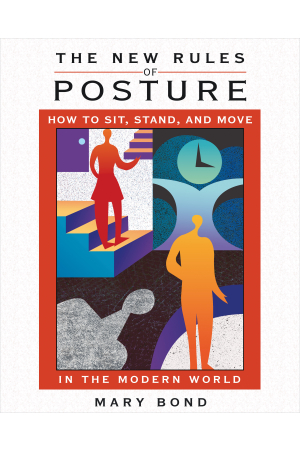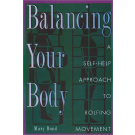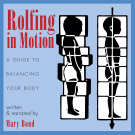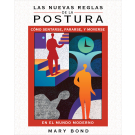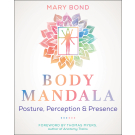Availability:
In Stock
- Pages: 240
- Book Size: 8 x 10
- ISBN-13: 9781594771248
- Imprint: Healing Arts Press
- On Sale Date: November 29, 2006
- Format: Paperback Book
- Illustrations: 41 b&w illustrations
Mary Bond explains that healthy posture comes not by training our muscles into an ideal shape, but from a new sense that we can develop by learning to feel. She identifies the key anatomical features that impact alignment, and, proposing six zones that help create postural changes, she offers self-help exercises that enable healthy function in each zone.
A manual for understanding the anatomical and emotional components of posture in order to heal chronic pain
• Contains self-help exercises and ergonomics information to help correct unhealthy movement patterns
• Teaches how to adopt suitable posture in the modern sedentary world
Many people cause their own back and body pain through their everyday bad postural and movement habits. Many sense that their poor posture is probably the root of the problem, but they are unable to change long-standing habits.
In The New Rules of Posture, Mary Bond approaches postural changes from the inside out. She explains that healthy posture comes from a new sense we can learn to feel, not by training our muscles into an ideal shape. Drawing from 35 years of helping people improve their bodies, she shows how habitual movement patterns and emotional factors lead to unhealthy posture. She contends that posture is the physical action we take to orient ourselves in relation to situations, emotions, and people; in order to improve our posture, we need to examine both our physical postural traits and the self-expression that underlies the way we sit, stand, and move. The way we walk, she says, is our body’s signature.
Bond identifies the key anatomical features that impact alignment, particularly in light of our modern sedentary lives, and proposes six zones that help create postural changes: the pelvic floor, the breathing muscles, the abdomen, the hands, the feet, and the head. She offers self-help exercises that enable healthy function in each zone as well as information on basic ergonomics and case histories to inspire us to think about our own habitual movements. This book is a resource for Pilates, yoga, and dance instructors as well as healthcare professionals in educating people about postural self-care so they can relieve chronic pain and enjoy all life activities with greater ease.
• Contains self-help exercises and ergonomics information to help correct unhealthy movement patterns
• Teaches how to adopt suitable posture in the modern sedentary world
Many people cause their own back and body pain through their everyday bad postural and movement habits. Many sense that their poor posture is probably the root of the problem, but they are unable to change long-standing habits.
In The New Rules of Posture, Mary Bond approaches postural changes from the inside out. She explains that healthy posture comes from a new sense we can learn to feel, not by training our muscles into an ideal shape. Drawing from 35 years of helping people improve their bodies, she shows how habitual movement patterns and emotional factors lead to unhealthy posture. She contends that posture is the physical action we take to orient ourselves in relation to situations, emotions, and people; in order to improve our posture, we need to examine both our physical postural traits and the self-expression that underlies the way we sit, stand, and move. The way we walk, she says, is our body’s signature.
Bond identifies the key anatomical features that impact alignment, particularly in light of our modern sedentary lives, and proposes six zones that help create postural changes: the pelvic floor, the breathing muscles, the abdomen, the hands, the feet, and the head. She offers self-help exercises that enable healthy function in each zone as well as information on basic ergonomics and case histories to inspire us to think about our own habitual movements. This book is a resource for Pilates, yoga, and dance instructors as well as healthcare professionals in educating people about postural self-care so they can relieve chronic pain and enjoy all life activities with greater ease.
from the Introduction
“Hi there,” said the pretty checker as she reached across the counter to scan my purchases. In an instant her friendly smile dissolved. “Oh, man! I’ve got to get to the chiropractor.” I watched as she twisted her torso this way and that, trying to relieve the pain without attracting too much attention. But she had mine. Why was an attractive twenty-something complaining about her body to a customer? True, it was closing time, the end of a long day. But it was only Wednesday and the new Target had been open less than a week. Her name tag said “Carmen.” Maybe she was in a fender-bender, I thought, and that’s why she’s looking for a doctor. But just as likely not. Just as likely it was the way she used her body that had her tied in knots.
As a movement therapist, it’s my job to correct the poor posture and poor movement habits that underlie my clients’ complaints and symptoms. People often consult with me as a last resort when conventional medical approaches have failed to give them relief. Sometimes it takes months of gradual change for someone to transform his or her posture enough to eliminate pain, but sometimes there’s a quick and easy fix. I wondered whether I might find just the right comment to set Carmen on the road to healthy posture.
If I was to say something helpful, I needed to hit the mark with my assessment and offer a solution that would work right away. Most people have little patience for complicated advice about body maintenance.
The pretty woman was tall, five foot ten or more, with long legs and a short torso. When the cash drawer opened, it seemed low in relation to her height. As she reached for my change, folding inward at the waist as she must have done dozens of times that day, my own body signaled, “Ouch!” There it was, I felt sure: low back pain. Carmen was among the eighty-five percent of Americans who experience back pain sometime in their lives.
The checker’s ill-fitting workstation--tall girl/short counter--was part of her problem, but I wanted to consider other factors before offering a solution. Sometimes poor eyesight or bad lighting makes people hunch over their work. Poor posture caused by poor vision can persist even after vision has been corrected. But no, Carmen’s neck seemed free, with no trace of the forward straining neck tension that accompanies faulty eyesight or faulty hearing.
I glanced at the floor. Only a thin rubber mat protected the checker’s feet from the concrete floor. Hard surfaces take a toll on the best of feet. But Carmen’s shoes looked sturdy. Barring foot problems that I couldn’t see, the shoes seemed supportive enough.
Okay, then, what could I observe about the young woman’s spine? As she stood, Carmen’s lower back looked balanced, neither overly straight nor overly curved. But could she freely bend and straighten it? When she leaned forward, there was a smooth release of back muscles that let her vertebrae separate slightly as they must to allow forward bending. So, no problem with her flexibility. Nor were her buttocks tucking under, a pattern that could fix her lower back in a bent position, that could make straightening a hazard. Seemingly her spine was as adaptable as it looked.
Finally I saw both problem and solution. Carmen was stuck in a pattern I usually associated with women over thirty, so it had taken me a while to notice: camouflaged within the girl’s tight jeans was a flaccid belly--not a fat belly, just an under-active one. I watched as she bent to retrieve a box of tissues that had fallen to the floor. She straightened, then reached down again for a shopping bag. Each time she bent down, her belly bulged forward. In healthy forward bending, the abdominal organs settle back into the abdominal cavity. Because Carmen’s abdominal muscles were lax, her organs fell forward, putting unnecessary drag on her lower vertebrae. She desperately needed abdominal support.
If only I could show this woman how to engage what I call the “inner corset.” In my mind’s eye she grew statuesque. I imagined her jeans fitting better, her chest opening, her shoulders relaxing, and her back pain a distant memory. And, with better abdominal support, Carmen might unexpectedly benefit from improved digestion. Emotionally, she’d be better able to contain her “gut feelings,” and have better boundaries to her relationships.
She’d bagged my purchases by now. It would take only minutes to explain.
But it was closing time. Shoppers, no doubt many of them also wishing for a chiropractic adjustment, clamored in line behind me, hoping to get the kids to bed before ten. I handed Carmen my card. “I can help you with your back,” I said, as the customer behind me jostled into place. The checker gave me a blank look. “Have a good night,” she said.
WHY HEAL YOUR POSTURE?
Such a picture is not unfamiliar, but it doesn’t have to be true. You can have a body that stands gracefully and moves effortlessly throughout life once you learn to use it the way it is designed to be used. It is never too soon, or too late, to heal your posture.
Foreword by Leon Chaitow, N.D., D.O.
Preface
Introduction: What Are the New Rules of Posture?
PART ONE: AWARENESS
1. Your Conscious Body
2. Your Body’s Internet
PART TWO: STABILITY
3. The Root of Posture
4. Healthy Breathing
5. Core Connections
PART THREE: ORIENTATION
6. Your Heart’s Messengers
7. Footprints
8. Facing the World
PART FOUR: MOTION
9. Healthy Walking
10. Articulate Living
Afterword: Explore the New Rules of Posture, Together
Appendix: Therapeutic Resources for Healthy Posture
Bibliography
Index
EXPLORATIONS AND PRACTICES
1. YOUR CONSCIOUS BODY
Your Neutral Breath
A Stressful Moment
Simple Pleasure
Walking Inventory
Your Best Foot
Heel Strike
Pelvic Mobility
Arm Swing
Spinal Mobility
Head and Neck
Stabilizing Actions
2. YOUR BODY’S INTERNET
Postural Sway
Fascial Continuity
Sacroiliac Rocking
Holistic Impact
Counterrotation of Pelvis and Chest
Curling and Arching
3. THE ROOT OF POSTURE
Pelvis Palpation
The Pelvic Floor Diamond
The Anal Triangle
Slouching
Supported Sitting
Bending Over
Perceptual Fine Tuning
Smart Reclining
4. HEALTHY BREATHING
Quiet Breathing
Active Breathing
Global Breathing Awareness
Breathing in Your Back
Inhaling Beauty
Exhaling Surrender
The Spaciousness and Weight of Breathing
Breathing in Gravity
Slowing Your Breath with Sound
Healthy Breathing, Healthy Posture
5. CORE CONNECTIONS
Activating Your TA through the Pelvic Floor
Activating Your TA from a Table Position
Activating Your TA Lying Down
A Shortcut to the Inner Corset
Flying Table
Bending Forward and Bending Down
Posture as Relationship
6. YOUR HEART’S MESSENGERS
A Tour of Your Shoulders
Closing Your Shoulders
Shoulder Expression
Leverage
Shoulder Blade Pulses
Handprints on the Wall
Serratus Shortcut
Seated Sphinx
Reaching
Wall Traction
First Aid for Your “Mouse Arm”
Sacred Touch, Living Touch
Two-way Touching
Lifting Something Heavy
7. FOOTPRINTS
Self-assessment of Your Feet
Your Foot’s Dimple
Relaxing Your Arches
Footprints on the Wall
Opening Your Feet
Alternating Pressure between Forefoot and Heel
Rocking from Stance Foot to Walking Foot
Stepping into Your Whole Heel
Help for Bunions
Aligning Your Legs
Shifting Sands
Sitting to Standing
Pushing the Floor
Sacred Ground
8. FACING THE WORLD
Jaw and Tongue Tensions
Nose and Palate Tension
Jaw and Inner Ear
Distinguishing Cranium and Face
Narrow Focus and Open Focus
Releasing Eye Tension
Receptive Eyes
Welcoming the World
9. HEALTHY WALKING
Stop and Go
Wall Traction Enhanced
Flying Table Enhanced
Hip Rotation
Counterrotation
Pelvic Gyroscope
Seated Spine Spirals
Initiating a Step
One Step
One Step with Rotation
Forget About It
10. ARTICULATE LIVING
Body Parts Art
Acceleration
Your Best Walk
Your Worst Walk
Walking Your Way out of a Funk
Mary Bond has a Master’s degree in dance from UCLA and trained with Dr. Ida P. Rolf as a Structural Integration practitioner. She is a movement instructor at the Rolf Institute and teaches movement workshops nationally. The author of Balancing Your Body, she has also published articles in numerous health and fitness magazines. She lives in California.
“Few things are as overlooked and yet absolutely critical to our health and well being as our posture. Mary Bond offers information, stories and tools for learning how to stand and move with ease and elegance.”
Judith Hanson Lasater, Ph.D, PT, author of 30 Essential Yoga Poses
“The New Rules of Posture is a good adjunct to bodywork of all kinds, from chiropractic and osteopathy to Pilates and yoga. Read it thoroughly, let it soak into your experience--your body will thank you.”
Thomas Myers, author of Anatomy Trains
“Mary Bond’s talent and expertise extended my professional dance career until age 52! Anyone who suffers from body dysfunction and pain must read her book. Actually, it should be mandatory reading for all institutions offering anatomy, kinesiology, and medical courses.”
Bonnie Oda Homsey, Former member of the Martha Graham Dance Company, and Artistic Director of American Repertory Dance Company
“I have long searched for a book that addresses the human body as a whole, and with clarity, guidance, and completeness. This book is a multi-faceted gem offering all of that and much more--I highly recommend it to teachers of movement and to anyone eager to learn how to become a better occupant of their body.”
Marie-José Blom-Lawrence, Pilates Specialist and Professor of Anatomy and Physiology, Department of Dance, Southern California Loyola Marymount University
“At last, at any level of knowledge of the body and movement, everyone will have the joy of a discovery that can profoundly change our relationship to ourselves, to others and to the beauty of the world.”
Hubert Godard, Ph.D., Professor of Movement and Research, University of Paris
"Recommended for anyone interested in the anatomical and emotional aspects of the movement of one’s body."
Dede Archer, Library Journal, Feb 15, 2007
Judith Hanson Lasater, Ph.D, PT, author of 30 Essential Yoga Poses
“The New Rules of Posture is a good adjunct to bodywork of all kinds, from chiropractic and osteopathy to Pilates and yoga. Read it thoroughly, let it soak into your experience--your body will thank you.”
Thomas Myers, author of Anatomy Trains
“Mary Bond’s talent and expertise extended my professional dance career until age 52! Anyone who suffers from body dysfunction and pain must read her book. Actually, it should be mandatory reading for all institutions offering anatomy, kinesiology, and medical courses.”
Bonnie Oda Homsey, Former member of the Martha Graham Dance Company, and Artistic Director of American Repertory Dance Company
“I have long searched for a book that addresses the human body as a whole, and with clarity, guidance, and completeness. This book is a multi-faceted gem offering all of that and much more--I highly recommend it to teachers of movement and to anyone eager to learn how to become a better occupant of their body.”
Marie-José Blom-Lawrence, Pilates Specialist and Professor of Anatomy and Physiology, Department of Dance, Southern California Loyola Marymount University
“At last, at any level of knowledge of the body and movement, everyone will have the joy of a discovery that can profoundly change our relationship to ourselves, to others and to the beauty of the world.”
Hubert Godard, Ph.D., Professor of Movement and Research, University of Paris
"Recommended for anyone interested in the anatomical and emotional aspects of the movement of one’s body."
Dede Archer, Library Journal, Feb 15, 2007
HEALTH / EXERCISE
“The New Rules of Posture is a good adjunct to bodywork of all kinds, from chiropractic and osteopathy to Pilates and yoga. Read it thoroughly, let it soak into your experience--your body will thank you.”
--Thomas Myers, author of Anatomy Trains
“Few things are as overlooked and yet absolutely critical to our health and well-being as our posture. Mary Bond offers information, stories, and tools for learning how to stand and move with ease and elegance.”
--Judith Hanson Lasater, Ph.D., PT, author of 30 Essential Yoga Poses
Many people cause their own back and body pain through their everyday bad postural and movement habits. Many sense that their poor posture is probably the root of the problem, but they are unable to change long-standing habits.
In The New Rules of Posture, Mary Bond approaches postural changes from the inside out. She explains that healthy posture comes from a new sense we can learn to feel, not by training our muscles into an ideal shape. Drawing from thirty-five years of helping people improve their bodies, she shows how habitual movement patterns and emotional factors lead to unhealthy posture. She contends that posture is the physical action we take to orient ourselves in relation to situations, emotions, and people; in order to improve our posture, we need to examine both our physical postural traits and the self-expression that underlies the way we sit, stand, and move. The way we walk, she says, is our body’s signature.
Bond identifies the key anatomical features that impact alignment, particularly in light of our modern sedentary lives, and proposes six zones that help create postural changes: the pelvic floor, the breathing muscles, the abdomen, the hands, the feet, and the head. She offers self-help exercises that enable healthy function in each zone as well as information on basic ergonomics and case histories to inspire us to think about our own habitual movements. This book also is a resource for Pilates, yoga, and dance instructors as well as healthcare professionals in educating people about postural self-care so they can relieve chronic pain and enjoy all life activities with greater ease.
MARY BOND has a Master’s degree in dance from UCLA and trained with Dr. Ida P. Rolf as a Structural Integration practitioner. She is a movement instructor at the Rolf Institute and teaches movement workshops nationally. The author of Balancing Your Body, she has also published articles in numerous health and fitness magazines. She lives in California.
“The New Rules of Posture is a good adjunct to bodywork of all kinds, from chiropractic and osteopathy to Pilates and yoga. Read it thoroughly, let it soak into your experience--your body will thank you.”
--Thomas Myers, author of Anatomy Trains
“Few things are as overlooked and yet absolutely critical to our health and well-being as our posture. Mary Bond offers information, stories, and tools for learning how to stand and move with ease and elegance.”
--Judith Hanson Lasater, Ph.D., PT, author of 30 Essential Yoga Poses
Many people cause their own back and body pain through their everyday bad postural and movement habits. Many sense that their poor posture is probably the root of the problem, but they are unable to change long-standing habits.
In The New Rules of Posture, Mary Bond approaches postural changes from the inside out. She explains that healthy posture comes from a new sense we can learn to feel, not by training our muscles into an ideal shape. Drawing from thirty-five years of helping people improve their bodies, she shows how habitual movement patterns and emotional factors lead to unhealthy posture. She contends that posture is the physical action we take to orient ourselves in relation to situations, emotions, and people; in order to improve our posture, we need to examine both our physical postural traits and the self-expression that underlies the way we sit, stand, and move. The way we walk, she says, is our body’s signature.
Bond identifies the key anatomical features that impact alignment, particularly in light of our modern sedentary lives, and proposes six zones that help create postural changes: the pelvic floor, the breathing muscles, the abdomen, the hands, the feet, and the head. She offers self-help exercises that enable healthy function in each zone as well as information on basic ergonomics and case histories to inspire us to think about our own habitual movements. This book also is a resource for Pilates, yoga, and dance instructors as well as healthcare professionals in educating people about postural self-care so they can relieve chronic pain and enjoy all life activities with greater ease.
MARY BOND has a Master’s degree in dance from UCLA and trained with Dr. Ida P. Rolf as a Structural Integration practitioner. She is a movement instructor at the Rolf Institute and teaches movement workshops nationally. The author of Balancing Your Body, she has also published articles in numerous health and fitness magazines. She lives in California.



